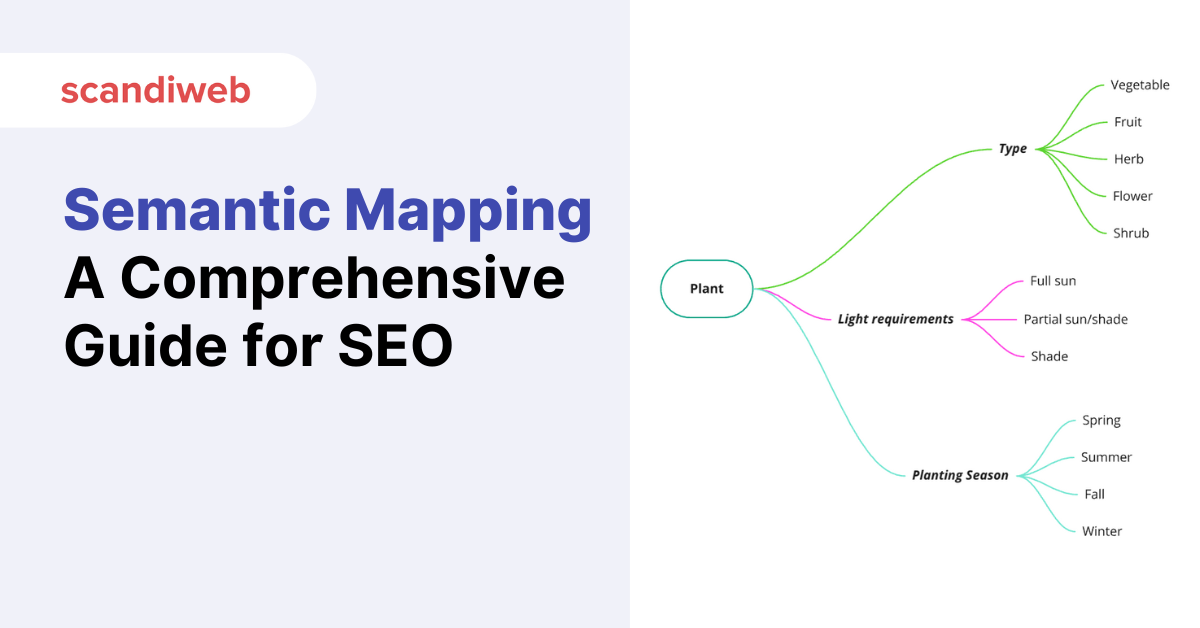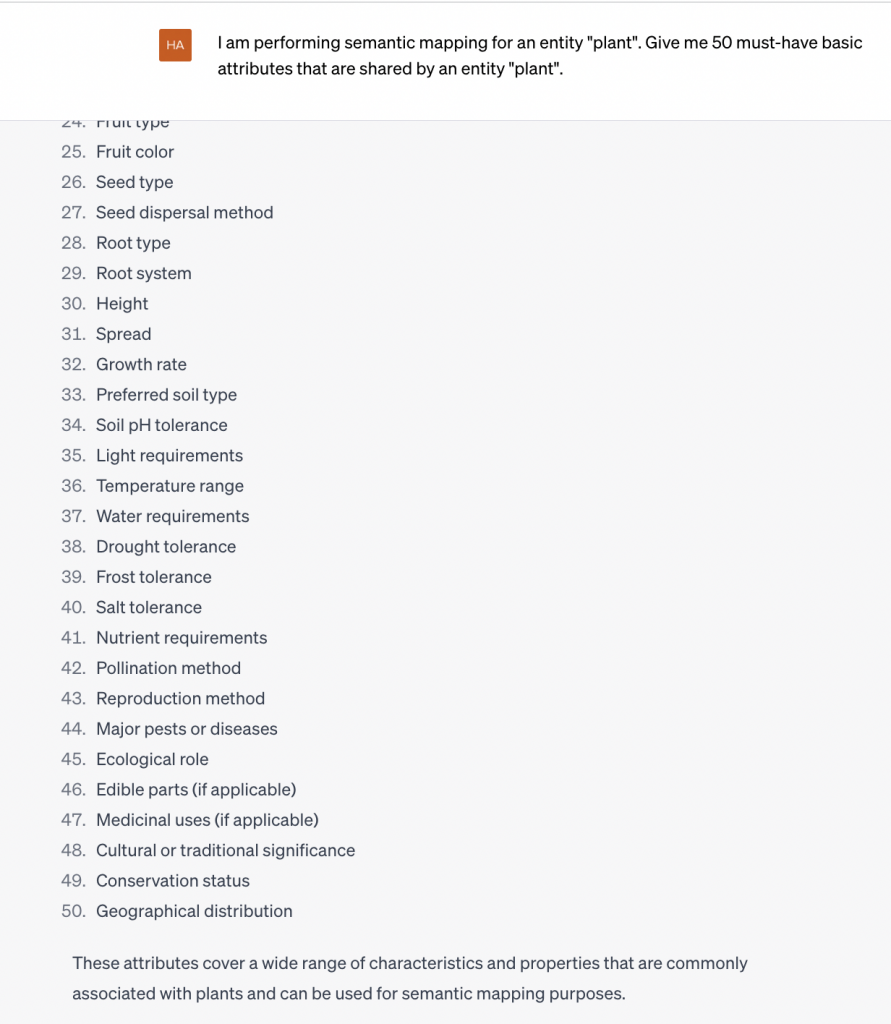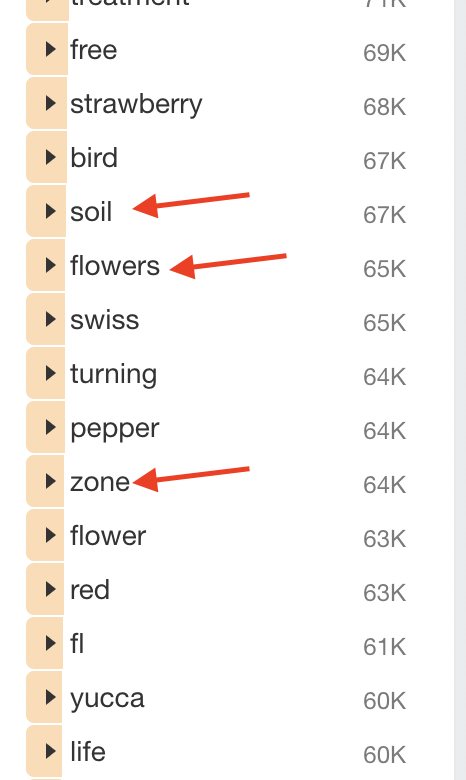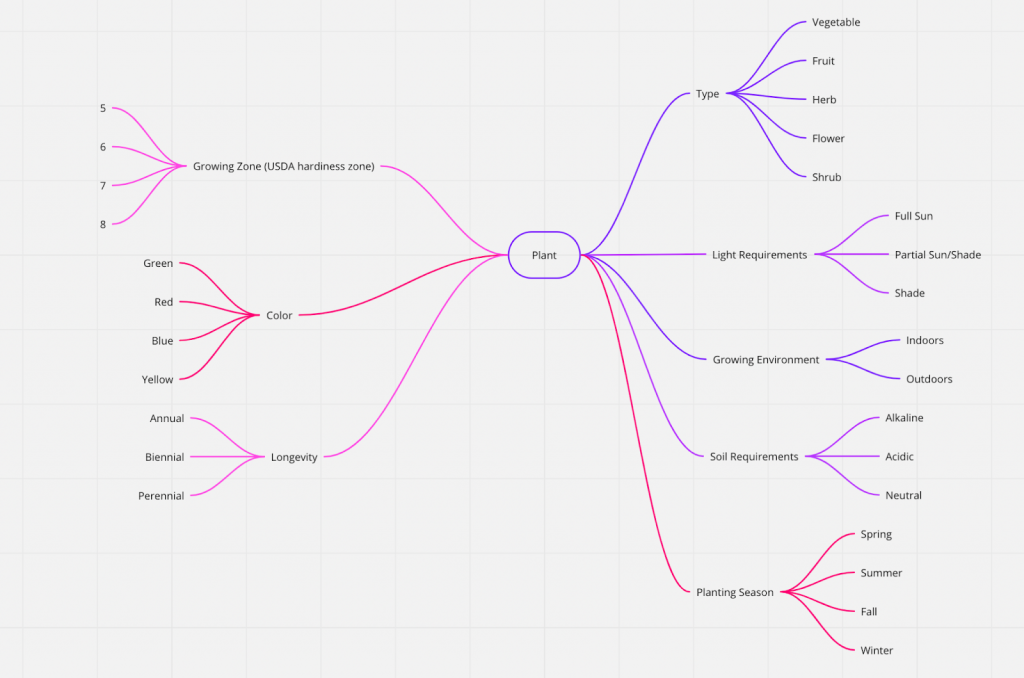When performing semantic mapping, we examine every aspect of a product—making it essentially a comprehensive form of product research. Developing a thorough understanding of a product is essential for effective SEO. Therefore, engaging in semantic mapping not only facilitates this understanding but is also an integral objective of the process. In this guide, we’ll walk you through the steps and techniques of semantic mapping to optimize your SEO efforts effectively.
What is semantic mapping and what is the goal of the process?
Semantic mapping is a way to graphically represent concepts. In the context of SEO, a semantic map aims to provide a comprehensive overview of a selected entity and relevant attributes or other entities around it and is then used as a blueprint to optimize the website. We highlight “relevant” because when you add items to a semantic map, it should be because you think the information might be helpful to users.
Semantic mapping helps us build detailed and rich information about products, which is really important as AI starts to play a bigger role in search results. If we don’t describe a product feature clearly, it won’t get picked up by the AI, and that means the product won’t show up in search results based on that feature.
The main goal is to thoroughly understand our product, its related entities and attributes, and the keywords connected to them. Once we know these details, we can plan out how to best cover each keyword and use the product’s features and their specifics to target those keywords effectively in searches.
Where does semantic mapping figure in an SEO workflow?
Semantic mapping is most effective when integrated early in the SEO workflow, ideally soon after onboarding a new SEO client, especially for ongoing retainer services. This early integration allows for a deep dive into the client’s product details, providing a valuable opportunity to understand the product thoroughly. With this comprehensive understanding, you can develop more effective strategies from the start, setting the stage for improved SEO performance and client satisfaction.
Components of a deliverable and tools to use
The deliverable for semantic mapping in SEO includes two key components:
- Semantic map. This is a graphical representation of the main entity along with its attributes and related entities. A great tool for creating these maps is Miro, using the “Mind map” template. This visual tool helps in laying out the connections and hierarchy of information clearly and effectively.
- Keyword data in a spreadsheet. This involves compiling data related to the main entity and its attributes. A spreadsheet is used to organize and analyze this keyword data, which includes metrics like search volume and priority. For gathering and analyzing these metrics, keyword research tools like Ahrefs or Semrush are recommended. These tools provide detailed insights into keyword performance and competition, which are crucial for effective SEO strategy planning.
Steps for effective semantic mapping
1. Selecting the scope
Before diving into the process, it’s crucial to define the scope of the mapping based on the client’s project and the products they offer.
Examples:
- A company selling a wide variety of plants might start with a broad scope. The primary broad entity, “plant,” encompasses attributes applicable to all their products. Once the broad entity has been mapped, the focus can shift to more specific product groups.
- Similarly, a company specializing in touch screen technologies might initially benefit from exploring broad topics such as industry applications and use cases related to the main “touch screen” entity. This broad approach aligns well with their diverse product offerings, providing a solid foundation before moving into detailed product research.
- Conversely, a music label focusing on metal music might find immediate value in targeting specific product groups, such as artist merchandise or music albums. Starting with a broad category like “metal music” might generate too many irrelevant attributes, making implementation challenging.
- In another scenario, a supplier of construction materials might gain more from focusing on specific categories like “sealants” rather than the broader “construction supplies.” This narrower focus can immediately highlight actionable attributes like “UV resistance,” “VOC content,” and “strength,” which are directly relevant and implementable, unlike broader categories that might include products they don’t offer.
The choice between broad and specific scopes can also be influenced by the client’s market direction, such as a shift towards B2B operations, which might favor broader research.
In summary, the scope of semantic mapping should be carefully aligned with the client’s business priorities, objectives, and their ability to implement new functionalities suggested by the mapping outcomes.
2. Conducting main entity research and mapping
Once the scope is determined, we start performing detailed research to identify all relevant concepts, entities, and attributes associated with our main entity. During this research phase, we begin constructing the semantic map using a visualization tool like Miro.
Example | Main entity: Plant
Consider “plant” as our main entity. The research begins by identifying common attributes applicable to all plants. This involves a comprehensive approach, examining multiple sources to ensure thoroughness.
- Using AI for initial ideas. ChatGPT can be a valuable resource to quickly generate initial attribute ideas. For example, you can request it to suggest 50 essential attributes for plants, which you can then review and select the most relevant ones for your semantic map. Of course, you can always add more items that you think are relevant.

- Competitor website analysis. This crucial step involves examining how competitors structure information on their sites. When dealing with a broad entity like “plant,” we are interested in:
- Categories and subcategories: Are they categorizing by planting zone and you aren’t? Are they categorizing by light requirements and you aren’t? Do they have separate categories for plant types and you don’t?
- Layered navigation in broad categories: Check the attributes competitors use to filter products on categories and where layered navigation is present.
- Any attribute information on the product pages that could be applied to your main entity.
- Engaging with blogs and forums. Blogs and forums dedicated to plants often discuss critical considerations for your main entity, which can be valuable for categorization or displaying product attributes. For example, when we look at the entity “plant,” a common related topic is “planting calendar.” From this we can gather that planting dates are an important consideration for the target group. So to cover this interest, we could add it as an attribute prominently displayed on each product detail page (PDP).
- Keyword research with tools. Keyword research tools like Ahrefs or Semrush aren’t always the best option for exploring large entities with millions of keywords, simply because there isn’t enough time to go through all of them. Nevertheless, they can still be useful for quickly finding broader categorization ideas linked to the main entity.

Above, you can see the keyword groups that were used as ideas for the semantic map below. From “soil,” we can introduce “soil requirements” to our semantic map, as it’s an important consideration. Keywords like “flowers” can suggest different plant types to include, and “zone” can lead to adding categories based on planting zones. These insights help shape the structure of your semantic map efficiently.
Here’s an example of a semantic map with some basic attributes around the entity “plant.” It is not 100% complete, but it illustrates how the deliverable would look like on the visual side of things. Please note that this is just a basic semantic map and attribute values are added as examples—not all of them may be present.

When completing the semantic map, make sure you can justify each attribute you add and clearly understand how it will benefit the user.
3. Keyword research and coverage recommendations
After creating the semantic map, we proceed to assign keywords and offer coverage recommendations. This step is documented in a spreadsheet, which illustrates how the semantic map informs keyword assignments.
DOWNLOAD SAMPLE SEMANTIC MAPPING TABLE
Context: Seeds
In our example, our primary entity is “Plant,” which connects to all products offered by a certain company (let’s call it Company Plant Seeds). However, this company specializes in selling seeds, not plants. This distinction requires us to add “seeds” as the specific context to our plant entity.
Hence, we tailor our keyword research to focus on the “seed” context. This approach ensures that we capture more accurate and relevant keyword data, as opposed to general plant-related terms, which will not precisely reflect the products being sold.
The process consists of going through every attribute and attribute value included in the semantic map.
- Transfer all the attributes and their values to a spreadsheet.
- Begin researching keywords for each attribute value. Record their search volume and difficulty to gauge their potential for targeting. Analyze the Search Engine Results Page (SERP) intent for each keyword to ensure it aligns with possible targeting strategies. It’s also helpful to note down top-ranking content to understand what type of content Google currently favors as most helpful and relevant.
- The most critical step is deciding how to effectively cover these keywords based on the gathered data about search volume, SERP intent, and competitor analysis.
Let’s walk through this process using the “plant” entity example and explore each attribute value.
Analyzing each attribute
Attribute: Type | Values:
- Vegetable
- Fruit
- Herb
- Flower
- Shrub
These categories represent the types of seeds Company Plant Seeds offers, with most having high search volumes—indicating strong consumer interest in these classifications. Competitors are organizing them into primary categories, which makes sense because they are broad keywords. To effectively compete, Company Plant Seeds should also establish these as first-level categories to target them efficiently.
Attribute: Light requirements | Values:
- Full sun
- Partial shade
- Shade
This attribute is a bit tricky—none of the values has search volumes in the context of plant seeds. But it doesn’t necessarily mean that we can get nothing out of adding it to the company’s website. In this case, we found notable search volume in the keywords that combined the “light requirement” attribute values with other attribute values.
For example, keywords like “full-sun flower seeds” (light requirement + plant type) and “full sun perennials zone 5” (light requirement + longevity + growing zone) do exhibit noticeable search volumes. Although the term “seeds” is not directly mentioned in longer-tail keywords like the second example, SERP analysis indicates that searches still relate to seed purchasing intent.
Based on this, while it may not be necessary to create dedicated pages for each light requirement, including these attributes on product pages is crucial. They should be used strategically in attribute combinations to enhance search visibility and meet specific customer searches.
Attribute: Growing environment | Values:
- Indoors
- Outdoors
This attribute requires a nuanced approach. The term “indoor plant seeds” garners notable search volume, suggesting a strong market interest. In contrast, “outdoor plant seeds” doesn’t attract similar attention—with essentially zero search volume. Based on this disparity, our recommendations are as follows:
- For indoor plant seeds: Create a first-level category and add this attribute to relevant products.
- For outdoor plant seeds: While there’s no value in creating a separate page because of the lack of search volume, it’s essential to include this attribute on product pages. Attribute combinations like “outdoor flower seeds” (growing environment + plant type) enhance visibility for more specific searches.
Attribute: Soil requirements | Values:
- Alkaline
- Acidic
- Neutral
Although keywords related to soil pH values such as “alkaline,” “acidic,” or “neutral” don’t directly attract targeted search traffic in the context of seeds, it’s vital to still cover them. Soil pH significantly influences the solubility of nutrients in soil water, directly affecting nutrient availability to plants. People searching for information about seed germination or specific plant needs might also be interested in soil pH and its impact.
Given its importance to user experience, soil pH should be included as an attribute on every PDP on the website. This ensures that customers are well-informed about the soil requirements necessary for the successful growth of their plants, enhancing their shopping experience and satisfaction.
Attribute: Planting season | Values:
- Spring
- Summer
- Fall
- Winter
Seed keywords by planting season have some search volume, so they could potentially be covered through categories. However, there is more value in combining them with other attribute values, such as in “spring flower seeds” (planting season + plant type).
Attribute: Longevity | Values:
- Annual
- Biennial
- Perennial
Longevity-related keywords show promising potential. Specifically, “perennial seeds” attracts high search volumes and should have its own first-level category on the website. The keyword “annuals” could be considered for its own category, but “biennials” does not generate enough search interest to justify it.
Like the other attributes discussed, it’s essential to include longevity as an attribute of every product. Integrating these attributes into combinations is significant. For example, the combination of “perennials + zone” alone features over 3000 keywords in Ahrefs, highlighting the importance of these details in enhancing search visibility and user navigation on the site.
Attribute: Color | Values:
- Green
- Red
- Blue
- Yellow
There’s barely any search volume for “Color + seeds” keywords, so we should not be targeting them in a broad context. However, the color attribute and its values are still crucial to include on each product detail page. For certain product categories, color is a key consideration.
For instance, in the case of flowers, color is a significant factor for landscapers who need specific hues for garden designs. Thus, allowing users to browse flower seeds by color can greatly enhance their shopping experience, making it easier for them to find the perfect options for their projects.
Attribute: Growing zone | Values:
- Zone 5
- Zone 6
- Zone 7
- Zone 8
Keywords related to growing zones generate substantial search volume, including both general terms like “zone x plants” (in this context, keywords without “seeds” have a transactional intent) and more specific combinations of zones with other attributes. Some examples:
- perennial herbs zone 6 (longevity + type + zone)
- shade annual flowers zone 7 (light requirements + longevity + type + zone)
- zone 9a plants full sun (zone + core entity + light requirements)
Given the high interest and potential for detailed targeting, the optimal approach would be to create separate categories for each growing zone. Additionally, implementing indexable layered navigation would be highly beneficial, allowing the website to efficiently target valuable attribute combinations and cater to specific customer searches based on detailed criteria.
Wrapping up
By the end of the mapping process, we should clearly understand our chosen entity, know its key features, and recognize what parts of it interest our audience the most—with everything clearly documented and strategies on keyword targeting spelled out. This means:
- Understanding the main entity. We need to have a solid grasp of the main topic or item that the mapping revolves around. This includes understanding what it is, why it’s important, and how it fits into the broader industry or area it belongs to.
- Identifying key features. The process should also help us identify and document the specific characteristics or attributes that describe the main entity. These features provide more detail and help us understand the entity better.
- Knowing audience interests. It’s important to figure out which features or aspects of the main entity the audience cares about the most. This understanding can guide us in creating content that resonates with our audience.
It’s okay if we miss some details at first because the semantic map can grow and improve over time. We can always add new attributes to both the map and the website.
The crucial part is ensuring the website is technically equipped to target these attributes effectively. This means the website should be able to add and display product attributes, use indexable layered navigation, and create pages for listing products (PLPs) or specific categories (CLPs). This setup is essential for optimizing search visibility and enhancing user experience.
Want to see your products at the top of search results? Use the form below to reach out to our SEO experts. We can enhance your visibility using semantic mapping and strategic SEO tailored to your needs.






Share on: